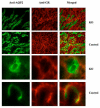The glucocorticoid receptor in the distal nephron is not necessary for the development or maintenance of dexamethasone-induced hypertension
- PMID: 20188070
- PMCID: PMC2946623
- DOI: 10.1016/j.bbrc.2010.02.123
The glucocorticoid receptor in the distal nephron is not necessary for the development or maintenance of dexamethasone-induced hypertension
Abstract
Glucocorticoids are used as a treatment for a variety of conditions and hypertension is a well-recognized side effect of their use. The mechanism of glucocorticoid-induced hypertension is incompletely understood and has traditionally been attributed to promiscuous activation of the mineralocorticoid receptor by cortisol. Multiple lines of evidence, however, point to the glucocorticoid receptor as an important mediator as well. We have developed a mouse model of glucocorticoid-induced hypertension, which is dependent on the glucocorticoid receptor. To determine the site(s) of glucocorticoid receptor action relevant to the development of hypertension, we studied glucocorticoid-induced hypertension in a mouse with a tissue-specific knockout of the glucocorticoid receptor in the distal nephron. Although knockout mice had similar body weight, nephron number and renal histology compared to littermate controls, their baseline blood pressure was mildly elevated. Nevertheless, distal nephron glucocorticoid receptor knockout mice and controls had a similar hypertensive response to dexamethasone. Urinary excretion of electrolytes, both before and after administration of glucocorticoid was also indistinguishable between the two groups. We conclude that the glucocorticoid receptor in the distal nephron is not necessary for the development or maintenance of dexamethasone-induced hypertension in our model.
2010 Elsevier Inc. All rights reserved.
Figures




Similar articles
-
Conditional Deletion of Hsd11b2 in the Brain Causes Salt Appetite and Hypertension.Circulation. 2016 Apr 5;133(14):1360-70. doi: 10.1161/CIRCULATIONAHA.115.019341. Epub 2016 Mar 7. Circulation. 2016. PMID: 26951843 Free PMC article.
-
Knockout of the vascular endothelial glucocorticoid receptor abrogates dexamethasone-induced hypertension.J Hypertens. 2011 Jul;29(7):1347-56. doi: 10.1097/HJH.0b013e328347da54. J Hypertens. 2011. PMID: 21659825 Free PMC article.
-
Prenatal overexposure to glucocorticoids programs renal 11β-hydroxysteroid dehydrogenase type 2 expression and salt-sensitive hypertension in the rat.J Hypertens. 2011 Feb;29(2):282-9. doi: 10.1097/HJH.0b013e328340aa18. J Hypertens. 2011. PMID: 21045727
-
Nephron number, hypertension, and CKD: physiological and genetic insight from humans and animal models.Physiol Genomics. 2017 Mar 1;49(3):180-192. doi: 10.1152/physiolgenomics.00098.2016. Epub 2017 Jan 27. Physiol Genomics. 2017. PMID: 28130427 Free PMC article. Review.
-
Glucocorticoid resistance in humans and nonhuman primates.Cancer Res. 1989 Apr 15;49(8 Suppl):2203s-2213s. Cancer Res. 1989. PMID: 2649236 Review.
Cited by
-
Endothelial glucocorticoid receptor is required for protection against sepsis.Proc Natl Acad Sci U S A. 2013 Jan 2;110(1):306-11. doi: 10.1073/pnas.1210200110. Epub 2012 Dec 17. Proc Natl Acad Sci U S A. 2013. PMID: 23248291 Free PMC article.
-
11β-Hydroxysteroid Dehydrogenases and Hypertension in the Metabolic Syndrome.Curr Hypertens Rep. 2017 Nov 14;19(12):100. doi: 10.1007/s11906-017-0797-z. Curr Hypertens Rep. 2017. PMID: 29138984 Free PMC article. Review.
-
Glucocorticoids and renal Na+ transport: implications for hypertension and salt sensitivity.J Physiol. 2014 Apr 15;592(8):1731-44. doi: 10.1113/jphysiol.2013.267609. Epub 2014 Feb 17. J Physiol. 2014. PMID: 24535442 Free PMC article. Review.
-
Dexamethasone increases aquaporin-2 protein expression in ex vivo inner medullary collecting duct suspensions.Front Physiol. 2015 Nov 3;6:310. doi: 10.3389/fphys.2015.00310. eCollection 2015. Front Physiol. 2015. PMID: 26578982 Free PMC article.
-
Glucocorticoid-induced hypertension.Pediatr Nephrol. 2012 Jul;27(7):1059-66. doi: 10.1007/s00467-011-1928-4. Epub 2011 Jul 9. Pediatr Nephrol. 2012. PMID: 21744056 Review.
References
-
- Mangos GJ, Whitworth JA, Williamson PM, Kelly JJ. Glucocorticoids and the kidney. Nephrology (Carlton) 2003;8:267–73. - PubMed
-
- Muller OG, Parnova RG, Centeno G, Rossier BC, Firsov D, Horisberger JD. Mineralocorticoid effects in the kidney: correlation between alphaENaC, GILZ, and Sgk-1 mRNA expression and urinary excretion of Na+ and K+ J Am Soc Nephrol. 2003;14:1107–15. - PubMed
-
- Naray-Fejes-Toth A, Fejes-Toth G. Glucocorticoid receptors mediate mineralocorticoid-like effects in cultured collecting duct cells. Am J Physiol. 1990;259:F672–8. - PubMed
Publication types
MeSH terms
Substances
Grants and funding
LinkOut - more resources
Full Text Sources
Other Literature Sources
Medical
Molecular Biology Databases

